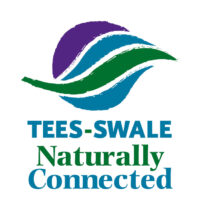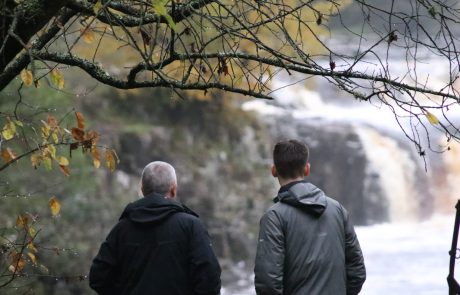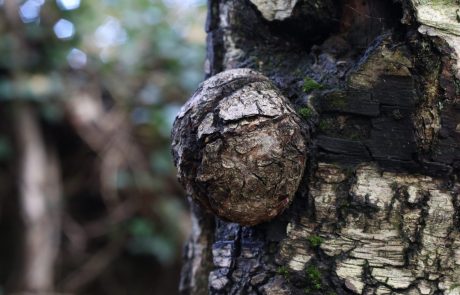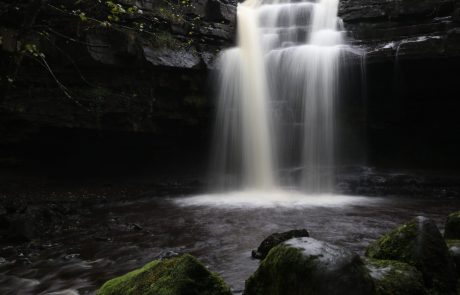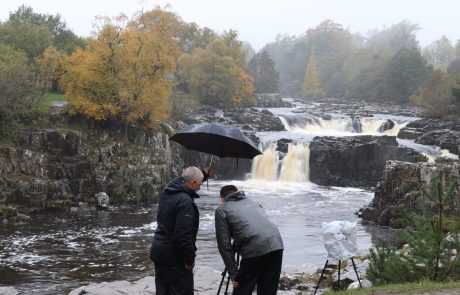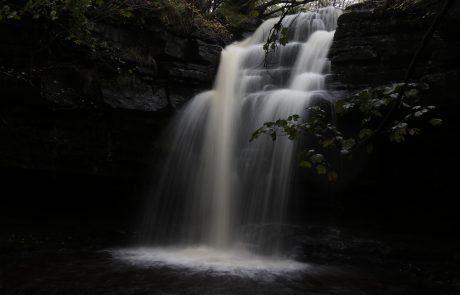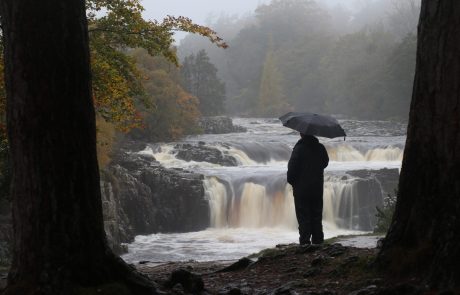News
There’s no such thing as bad weather
There’s no such thing as bad weather
Tees-Swale blog by Chloe Hedley, community engagement trainee
Keeping written and photographic records of the work we do in the North Pennines National Landscapes team is vital, and includes surveying plants, collating feedback, producing communications for events, and creating historical records. With this in mind, for part of my traineeship, I decided to book onto a SLR (single lens reflex) digital photography course with David Forster, a local ‘Tees-Dalian’ based in Barnard Castle, with the aim to learn how to create high quality photographs.
Our team doesn’t shy away from bad weather. We wouldn’t get our jobs done if we did. As Alfred Wainwright wrote, “There’s no such thing as bad weather, only unsuitable clothing.”. However, this autumn the country was hit with torrential rain causing flooding and widespread damage. The storms have been a worrying and constant reminder of the impact of climate change and the consequences to our lives and the environment. The Tees-Swale programme includes projects to help mitigate climate change, including a substantial peatland restoration programme and the creation of scrapes (small upland ponds) to slow the flow of water. The day before the photography course I checked the weather forecast hoping for some good conditions for taking pictures – nope. One hundred percent chance of constant rain. All. Day. Never mind, I guess it was time to dig out the wellies, again.
Kitted up with warm layers, waterproofs, and bags to protect the camera equipment, I crossed the north eastern boundary of the North Pennines National Landscape at Edmundbyers, driving south into Weardale and then west across to Teesdale. This route has beautiful scenery – vast open moorland, meadows, and big skies. At this time of year there are common sightings of red grouse and pheasants. The sheep, hardened to the sound of vehicles heading their way, lazily stumble sideways off the road whilst grabbing a last lick of basalt. The odd buzzard or red kite hovers in the sky and, if you’re really lucky, a pair of short eared owls make an appearance as you dip down into Teesdale. These are one of the most active British owls and can often be seen in the daytime. They have an overall tawny appearance they have small ear tufts and bright yellow eyes. From here blocks of white appear – tenant farmhouses dotted around the landscape. I head towards them. The road bends past High Force, the famous waterfall, and I follow the river up to Bowlees Visitor Centre. I enter Bowlees car park to see David Forster sheltering miserably under the open boot of his car.
Jenny Docket (interpretation officer with the Tees-Swale project) and Joe Everitt (Farming and nature trainee with the Tees-Swale project based in Swaledale) were also participating in the course. After a brief group chat, mainly about the weather, David gave his introductions and talked about his aims for the day. The plan was for it to be quite participant-led, with us making decisions on where we wanted to go and what we wanted to photograph with David there to guide us with his expertise.
We headed down to Bow Lee Beck, which runs close to the car park, and found a nice spot to get to grips with using a tripod, setting up the camera, and playing about with different shutter speeds and iso (International Organization for Standardization that represents sensitivity to light as a numerical value). The trees around the visitor centre were full of rich colours and there was a beautiful copper beech on the bank ahead of us. Everything else around us was grey and drizzly. We were getting soaked so we decided to grab a hot drink at the Falls Café. It was really useful to have this time indoors to discuss the more technical side of photography, kit that works well, filters, tripods, different lenses, and to look through the menu settings of our cameras. Having someone on hand to advise on the options that you actually need to use was extremely helpful.
After we had dried off, we took the short walk to Summer Hill Force, tripods in hand. We set up in various stations around Gibson’s Cave, snapping away while David gave each of us individual tuition. This time I was more focused on what different lenses do and using RAW files, looking at how lighting affects the image quality of your files. It was a very dark and dreary day but I actually really enjoyed the moody affects. The overhanging rock of Gibson’s Cave looked dark black, which contrasted nicely with the fast flowing white water. Time went fast while we were absorbed in nature through the lens and were only awoken by the growls of hunger in our stomachs. After seeking shelter and lunch, with more camera chat, we walked down to Low Force. The trees around the waterfall were bursting with autumnal colour and it made me thankful that we had braved the weather. This section of the day was a chance for us to apply the skills we had gained earlier. There is something very special about outdoor photography. I think it forces you to truly look at your surroundings and study nature. I love the action of setting everything up to get that one good shot, and the whole process of how light, colour, distance, and weather affects our image, as well as the mechanical crrr clunk when the shutter opens and closes.
It was a lovely day during which I learnt some invaluable skills which I will apply to my work going forward. I also highly recommend David as a tutor. One of the main things I’m enjoying about the Tees-Swale programme is the inclusion it offers to the local community to share their skills and knowledge. There is a small but thriving community of artist and makers in Teesdale, all happy to contribute and lend a hand. Martin Rogers, another local photographer, is a great example of this – he’s been plying me with advice and photography books, and he kindly put me in touch with David.
Teesdale is full of creative inspiration, an abundance of flora and fauna, wildlife, rugged landscapes, history and, of course, waterfalls. It gives us all an opportunity to be inspired, to create, observe or record and, in my opinion, that is pretty special.
For more information on courses run by David, please visit his website. You’ll see Martin Rogers’ work in the shop at Bowlees Visitor Centre and on his website.
The Tees-Swale: Naturally Connected programme is funded by The National Lottery Heritage Fund and led by the North Pennines National Landscape team in collaboration with the Yorkshire Dales National Park.
